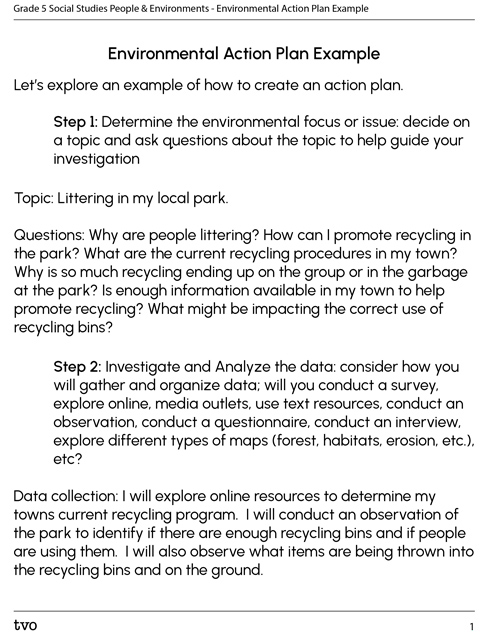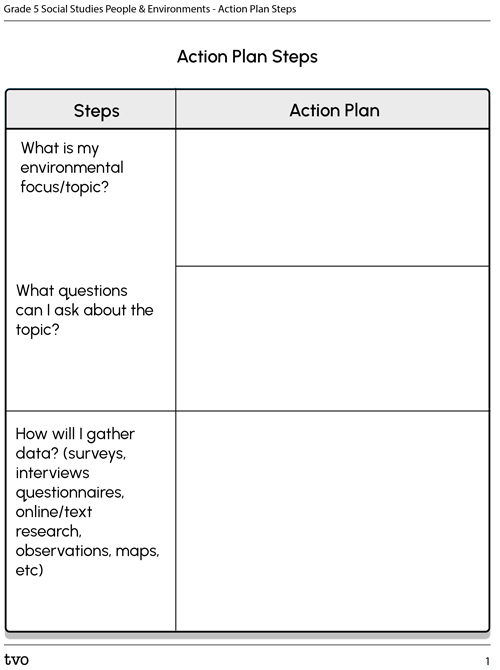Minds On
How can we help the environment?

Explore the following list:
- recycling
- using a compost bin for food waste
- installing wind turbines
- using electric cars
- planting trees
- keeping our water clean
- cleaning up garbage
Brainstorm
How do these actions help the environment?
Consider how these actions help solve environmental issues. How are these actions helping the environment? What issues are these actions helping to solve?
What level of government might be involved?
Record your ideas on paper, on the computer, as an audio clip or using another method of your choice.
Action
Environmental responsibilities
The environment is an important focus for all levels of government.
All three levels are involved with different aspects of maintaining and supporting the environment.

Take some time to explore the following environmental responsibilities. As you do, consider what level of government is responsible for each.
- natural resources
- city parks
- water and sewer services
- garbage and recycling
- provincial parks
- national parks
- industry pollution
- climate change
- air quality
- wildlife and habitat protection
- transportation emissions
Once you have finished, use the following fillable and printable document Government Responsibilities Venn Diagram to organize your choices. You can also complete this activity in your notebook or using a method of your choice.
Press Hint for a reminder about government responsibilities.

Press the Activity button to access the Government Responsibilities Venn Diagram.
Activity(Opens in a new tab)Press Hint to access suggested answers.
Federal: Natural resources (trees, lakes/rivers, minerals), national parks, industry pollution, air quality, wildlife and habitat protection, climate change, transportation emissions
Provincial/Territorial: Natural resources (trees, lakes/rivers, minerals), provincial parks, industry pollution, wildlife and habitat protection
Municipal: City parks, water and sewer services, garbage and recycling, wildlife protectionProtecting the environment is a large task that needs support from all levels of government and all citizens.
Let’s explore some ways citizens like ourselves have contributed to protecting the environment.
Protecting the environment
Students all over Canada are taking it upon themselves to affect change in positive ways. Explore the following video to learn more about some important environmental issues.
Brainstorm
What issues are affecting the environment?

Reflect on what you know and what you have learned to create a list of environmental issues.
These issues can be a focus for any level of government (municipal, provincial/territorial, federal).
Press Hint for a few examples.
- recycling
- garbage/waste
- drinking water
- industrial practices
- wildlife/habitats
- air quality
- climate change
- forests
- fishing
- ice caps
- transportation emissions
- littering
- erosion
Record your ideas using a method of your choice.
Now that we’ve explored our responsibilities towards the environment and the issues that are affecting it, let’s review how to create an action plan. This will help you address one of the current issues.
Reviewing steps of an action plan
Remember, when creating an action plan, there are five steps that can be followed. These are the same steps used in the previous learning activity, but now we’re focusing on the environment.
Press Explore to access the steps.
Step 1: Determine the environmental focus or issue: decide on a topic and ask questions about the topic to help guide your investigation
Step 2: Investigate and analyze the data: consider how you will gather and organize data. You can conduct a survey, explore online, media outlets, and text resources, conduct an observation, conduct a questionnaire, conduct an interview, explore different types of maps (forest, habitats, erosion, etc.) etc
Step 3: Determine the level of government: decide which level(s) of government need to be involved to help address the environment issue
Step 4: Brainstorm: determine different ways to help solve the environmental issue
Step 5: Action plan: specify why this environmental issue is important, specify the actions to be taken by the appropriate level(s) of government and citizens, and the information/data you would include in order to support your action planIf you would like another example of an action plan, this time relating to the environment, open and explore the following document Environmental Action Plan Example.

Press the Activity button to access the Environmental Action Plan Example.
Activity(Opens in a new tab)Consolidation
Let’s take action!

What environmental issue drive you to make change? In this section, you will be creating your own action plan which focuses on an environmental issue of your choice.
Creating an environmental action plan
Create your own action plan which focuses on an environmental issue of your choice. What environmental issue drives you to make change? In this section, you will be creating your own action plan that focuses on an environmental issue of your choice.
Press Hint for some examples.
- recycling
- garbage/waste
- drinking water
- industrial practices
- wildlife/habitats
- air quality
- climate change
- forests
- fishing
- ice caps
- transportation emissions
- littering
- erosion
You can also explore the following videos for inspiration!
Use the following steps as you create your plan. You can also use this interactive checklist as you complete the steps.
Action plan steps
Use and complete the following fillable and printable Action Plan Steps to create your action plan! You can also complete this activity in your notebook or using a method of your choice.
Reflection
As you read through these descriptions, which sentence best describes how you are feeling about your understanding of this learning activity? Press the button that is beside this sentence.
I feel...
Now, record your ideas using a voice recorder, speech-to-text, or writing tool.
Press 'Discover More' to extend your skills.
Discover MoreUsing the topic from your action plan, explore different community, provincial, or national services or organizations that are trying to help address the issue.
- How is your plan similar or different than what is currently being done?
- How can you use this information to enhance your idea?
Record your ideas using a method of your choice.
